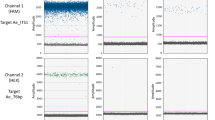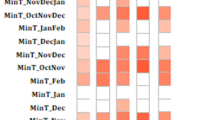Abstract
Phytophthora root rot (PRR) caused by Phytophthora medicaginis (Pm) is an important disease of chickpea in Australia. There are limited control options, with avoiding planting chickpeas in paddocks with a high PRR risk a key management strategy. Currently, risk assessment is based solely on paddock history of PRR, without any measure of Pm inoculum. We developed a qPCR test to quantify Pm inoculum concentrations in soil and evaluated its ability to predict, prior to planting, PRR disease and yield loss in chickpea. The qPCR test was specific to Pm and did not cross react with other Phytophthora species found in Australian agricultural systems and was sensitive, being able to detect <1 Pm oospore/g soil. A field experiment showed no correlation between Pm DNA concentration at seeding and PRR development on the susceptible chickpea variety, Sonali. Field experiments with Yorker, a PRR moderately resistant variety, showed Pm DNA concentration at seeding was correlated with PRR development and grain yield, but relationships varied with season and soil moisture (2015, irrigated r2 0.752, dryland r2 0.532; 2017 irrigated r2 0.52, dryland r2 0.0005), however above average rainfall in 2016 was highly conducive to PRR and there was no relationship between Pm DNA concentrations at seeding and PRR development or yield. The qPCR could detect moderate to high levels of Pm inoculum, but not low levels capable of causing disease and yield loss in conducive seasons. The Pm qPCR test showed potential to support in-field diagnostics.


Similar content being viewed by others
References
Almquist C, Persson L, Olsson A, Sundstrom J, Jonsson A (2016) Disease risk assessment of sugar beet root rot using quantitative real-time PCR analysis of Aphanomyces cochlioides in naturally infested soil samples. Eur J Plant Pathol 145(4):731–742. https://doi.org/10.1007/s10658-016-0862-5
Amalraj A, Taylor J, Bithell S, Li Y, Moore K, Hobson K, Sutton T (2019) Mapping resistance to Phytophthora root rot identifies independent loci from cultivated (Cicer arietinum L.) and wild (Cicer echinospermum P.H. Davis) chickpea. Theor Appl Genet 132(4):1017–1033. https://doi.org/10.1007/s00122-018-3256-6
Anon (2019) Australian plant pest database. Available via Plant Health Australia. https://appd.ala.org.au/appd-hub/index. Accessed 20 Oct 2019
Brinsmead RB, Rettke ML, Irwin JAG, Ryley MJ, Langdon PW (1985) Resistance in chickpea to Phytophthora megasperma f. sp. medicaginis. Plant Dis 69(6):504–506. https://doi.org/10.1094/pd-69-504
Cowie AL, Jessop RS, MacLeod DA (1996) Effects of waterlogging on chickpeas I. influence of timing of waterlogging. Plant Soil 183(1):97–103. https://doi.org/10.1007/BF02185569
Dale ML, Irwin JAG (1990) Estimation of inoculum potentials of Phytophthora medicaginis f. sp. medicaginis in chickpea fields and the development of a glasshouse resistance assay. Aust J Exp Agric 30(1):109–114. https://doi.org/10.1071/ea9900109
Dang YP, Dalal RC, Buck SR, Harms B, Kelly R, Hochman Z, Schwenke GD, Biggs AJW, Ferguson NJ, Norrish S, Routley R, McDonald M, Hall C, Singh DK, Daniells IG, Farquharson R, Manning W, Speirs S, Grewal HS, Cornish P, Bodapati N, Orange D (2010) Diagnosis, extent, impacts, and management of subsoil constraints in the northern grains cropping region of Australia. Aust J Soil Res 48(2):105–119. https://doi.org/10.1071/sr09074
GenStat Committee (2009) The guide to GenStat release 12 - parts 1–3. VSN International, Oxford
Haling E, Simpson RJ, McKay AC, Hartley D, Lambers HL, Ophel-Keller K, Wiebkin S, Herdina RIT, Richardson AE (2011) Direct measurement of roots in soil for single and mixed species using a quantitative DNA-based method. Plant Soil 348(1–2):123–137
Hulugalle NR, Weaver TB, Finlay LA, Hare J, Entwistle PC (2007) Soil properties and crop yields in a dryland vertisol sown with cotton-based crop rotations. Soil Tillage Res 93(2):356–369. https://doi.org/10.1016/j.still.2006.05.008
Hussain S, Lees AK, Duncan JM, Cooke DEL (2005) Development of a species-specific and sensitive detection assay for Phytophthora infestans and its application for monitoring of inoculum in tubers and soil. Plant Pathol 54(3):373–382. https://doi.org/10.1111/j.1365-3059.2005.01175.x
Knights EJ, Açıkgöz N, Warkentin T, Bejiga G, Yadav SS, Sandhu JS (2007) Chickpea breeding and management. In: Yadav SS, Redden RJ, Chen W, Sharma B (eds) Area, production and distribution. CABI, Wallingford, pp 167–178
Knights EJ, Southwell RJ, Schwinghamer MW, Harden S (2008) Resistance to Phytophthora medicaginis Hansen and Maxwell in wild Cicer species and its use in breeding root rot resistant chickpea (Cicer arietinum L.). Australian Journal of Agricultural Research 59 (4):383–387. doi:https://doi.org/10.1071/AR07175
Mitchell DJ, Kannwischer-Mitchell ME (1983) Relationship of inoculum density of Phytophthora species to disease incidence in various hosts. In: Erwin DC, Bartnicki-Garcia S, Tsao PH (eds) Phytophthora: its biology, taxonomy, ecology and pathology. American Phytopathological Society, St. Paul, pp 259–269
Ophel-Keller K, McKay A, Hartley D, Herdina CJ (2008) Development of a routine DNA-based testing service for soilborne diseases in Australia. Australas Plant Pathol 37(3):243–253
Patterson HD, Thompson R (1971) Recovery of inter-block information when block sizes are unequal. Biometrika 58:545–554
Pavon CF, Babadoost M, Lambert KN (2008) Quantification of Phytophthora capsici oospores in soil by sieving-centrifugation and real-time polymerase chain reaction. Plant Dis 92(1):143–149. https://doi.org/10.1094/pdis-92-1-0143
Pfender WF, Hine RB, Stanghellini ME (1977) Production of sporangia and release of zoospores by Phytophthora megasperma in soil. Phytopathology 67(5):657–663
Ristaino JB (1991) Influence of rainfall, drip irrigation, and inoculum density on the development of Phytophthora root rot and crown rot epidemics and yield in bell pepper. Phytopathology 81(8):922–929. https://doi.org/10.1094/Phyto-81-922
Ristaino JB, Larkin RP, Campbell CL (1993) Spatial and temporal dynamics of Phytophthora epidemics in commercial bell pepper fields. Phytopathology 83(12):1312–1320. https://doi.org/10.1094/Phyto-83-1312
Rojas JA, Jacobs JL, Napieralski S, Karaj B, Bradley CA, Chase T, Esker PD, Giesler LJ, Jardine DJ, Malvick DK, Markell SG, Nelson BD, Robertson AE, Rupe JC, Smith DL, Sweets LE, Tenuta AU, Wise KA, Chilvers MI (2017) Oomycete species associated with soybean seedlings in North America-part II: diversity and ecology in relation to environmental and edaphic factors. Phytopathology 107(3):293–304. https://doi.org/10.1094/phyto-04-16-0176-r
Salam M, Davidson J, Thomas G, Ford R, Jones RC, Lindbeck K, MacLeod W, Kimber RE, Galloway J, Mantri N, Leur JG, Coutts B, Freeman A, Richardson H, Aftab M, Moore K, Knights E, Nash P, Verrell A (2011) Advances in winter pulse pathology research in Australia. Australas Plant Pathol 40(6):549–567. https://doi.org/10.1007/s13313-011-0085-3
Schwinghamer MW (2011) Phytophthora root rot of chickpea. In: Chen W, Sharma HC, Muehlbauer FJ (eds) Compendium of chickpea and lentil diseases and pests. The American Phytopathological Society, St Paul, pp 22–25
Stack JP, Millar RL (1985) Relative survival potential of propagules of Phytophthora megasperma f. sp. medicaginis. Phytopathology 75(12):1398–1404. https://doi.org/10.1094/Phyto-75-1398
Than DJ, Hughes KJD, Boonhan N, Tomlinson JA, Woodhall JW, Bellgard SE (2013) A TaqMan real-time PCR assay for the detection of Phytophthora ‘taxon Agathis’ in soil, pathogen of kauri in New Zealand. For Pathol 43(4):324–330. https://doi.org/10.1111/efp.12034
Timmer LW, Sandler HA, Graham JH, Zitko SE (1988) Sampling Citrus orchards in Florida to estimate populations of Phytophthora parasitica. Phytopathology 78:940–944
Van der Heyden H, Walton T, Levesque CA, Carisse O (2019) Detection and quantification of Pythium tracheiphilum in soil by multiplex real-time qPCR. Plant Dis 103(3):475–483. https://doi.org/10.1094/pdis-03-18-0419-re
Vandemark GJ, Barker BM (2003) Quantifying Phytophthora medicaginis in susceptible and resistant alfalfa with a real-time fluorescent PCR assay. J Phytopathol 151(11–12):577–583. https://doi.org/10.1046/j.0931-1785.2003.00768.x
Vock NT, Langdon PW, Pegg KG (1980) Root rot of chickpea caused by Phytophthora megasperma var. sojae in Queensland. Australas Plant Pathol 9(4):117–117. https://doi.org/10.1071/APP9800117a
Wakeham AJ, Pettitt TR (2017) Diagnostic tests and their application in the management of soil- and water-borne oomycete pathogen species. Ann Appl Biol 170(1):45–67. https://doi.org/10.1111/aab.12315
Acknowledgments
This research was co-funded by NSW DPI and the Grains Research and Development Corporation (GRDC) under project DAS00137. The assistance provided by Gail Chiplin and Paul Nash at NSW DPI, and William Martin (DAF Q) is greatly appreciated.
Author information
Authors and Affiliations
Corresponding author
Electronic supplementary material
ESM 1
(DOCX 33 kb)
Rights and permissions
About this article
Cite this article
Bithell, S., Moore, K., Herdina et al. Phytophthora root rot of chickpea: inoculum concentration and seasonally dependent success for qPCR based predictions of disease and yield loss. Australasian Plant Pathol. 50, 91–103 (2021). https://doi.org/10.1007/s13313-020-00752-2
Received:
Accepted:
Published:
Issue Date:
DOI: https://doi.org/10.1007/s13313-020-00752-2




